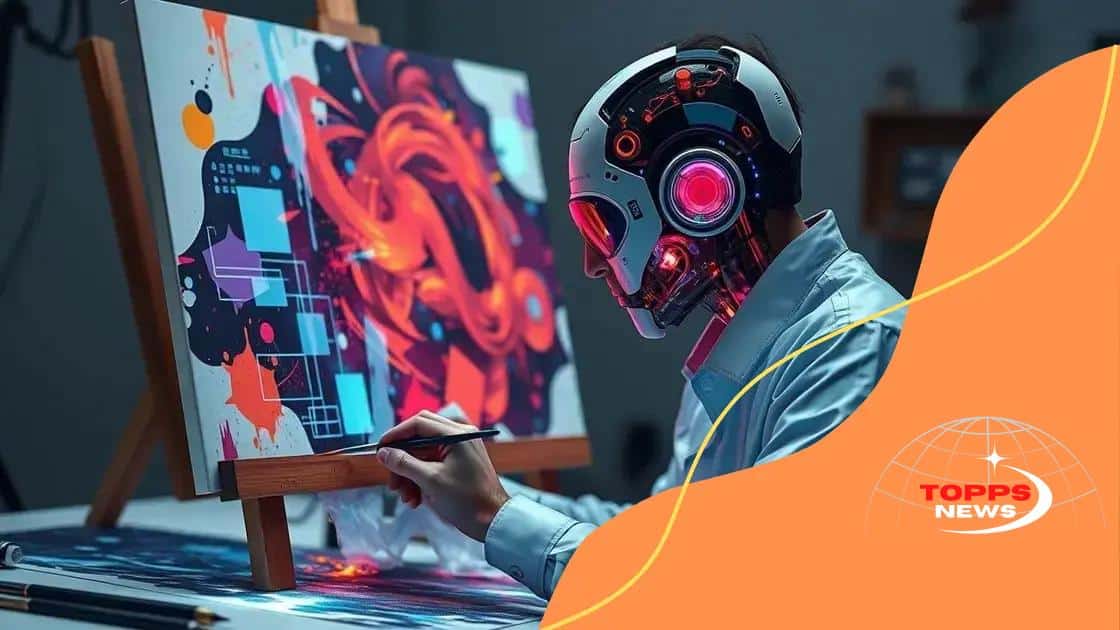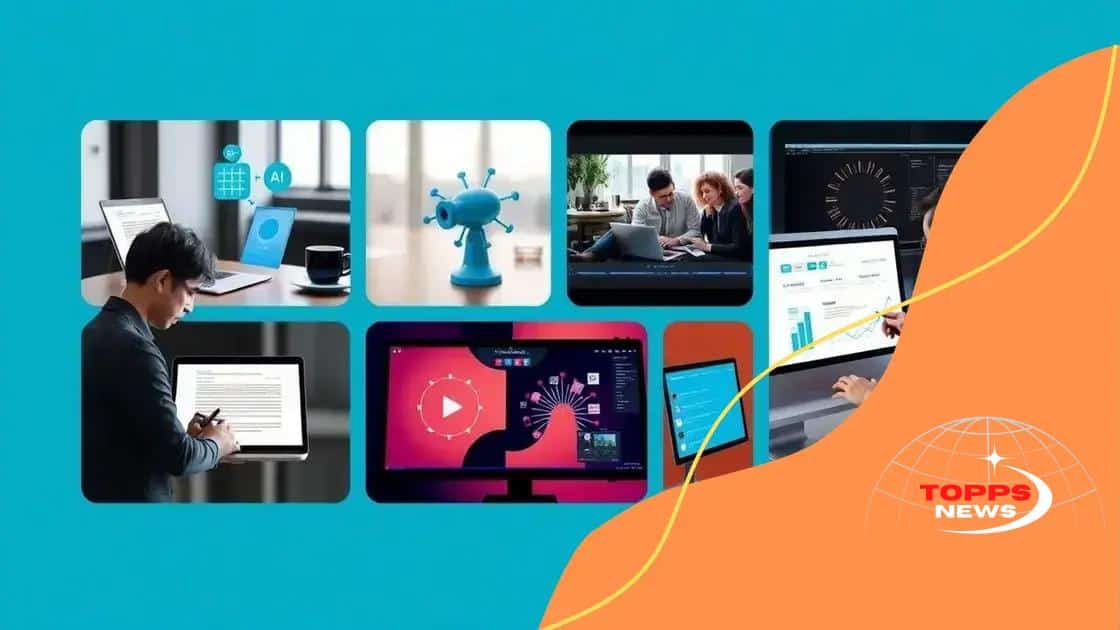The role of AI in transforming the creative industries

The role of AI in transforming the creative industries encompasses enhancing creativity, improving workflows, addressing ethical concerns, and fostering collaboration between human artists and AI tools.
In today’s digital landscape, the role of AI in transforming the creative industries is more significant than ever. Have you noticed how technology is reshaping creativity? Let’s dive into this fascinating evolution.
Understanding AI’s impact on creativity
Understanding AI’s impact on creativity requires a closer look at how technology intersects with artistic expression. With AI tools becoming increasingly influential, artists are discovering new ways to innovate and engage their audiences.
AI can assist in the creative process by providing unique insights and generating fresh ideas. Artists leverage these tools to push the boundaries of their imagination. For example, digital artists can use AI algorithms to create stunning visuals that may not have been possible otherwise. This fusion of technology and creativity opens up exciting possibilities.
How AI Enhances Artistic Expression
AI enhances artistic expression through various methods, enabling artists to explore new genres and mediums. Consider these examples:
- Generative art: Artists use algorithms to create visually striking images based on set parameters.
- AI-assisted music: Musicians collaborate with AI to compose music, introducing innovative sounds and styles.
- Filmmaking: Directors employ AI for script analysis and scene optimization, improving narrative flow.
The integration of AI into creative fields doesn’t mean that artists are being replaced. Instead, it serves as a collaborative partner. Artists can focus on the elements of their craft that resonate the most, while AI handles repetitive tasks or offers inspiration. This symbiosis can lead to breakthrough works that challenge conventional norms.
Real-world Examples of AI in Creative Processes
Many artists and creators are already using AI to great effect. For instance, some fashion designers utilize AI to predict trends by analyzing vast amounts of data. This approach provides insights that can help shape their collections. Additionally, novelists are finding value in AI tools that assist in plot development or character creation.
As the technology continues to evolve, the creative industries will likely see even greater changes. The question isn’t just about how AI influences creativity, but also about how it reshapes the landscape of artistic collaboration.
By understanding AI’s role in creativity, artists can embrace new tools while maintaining their unique voices. The key is to find a balance where technology empowers rather than overshadows the artistic spirit.
Case studies: AI in art and design
Case studies of AI in art and design reveal remarkable transformations in the creative landscape. These real-world examples highlight how artists are embracing technology to elevate their works.
One notable case is the use of AI in painting. Artists like Refik Anadol use algorithms to create mesmerizing data-driven artworks. By analyzing vast datasets, they can generate intricate visuals that are unique and captivating. This approach allows for a deeper exploration of themes and concepts.
AI in Graphic Design
In graphic design, platforms like Canva and Adobe spark leverage AI to assist designers. These tools can automate repetitive tasks, freeing up time for creative experimentation. AI analyzes design trends, suggesting layouts and color palettes that resonate with target audiences. This not only enhances productivity but also leads to innovative outcomes.
Another compelling example is the fashion industry. Designers are using AI for trend forecasting. By analyzing customer preferences and social media data, brands like Stitch Fix can recommend personalized outfits. This blend of technology and fashion creates a more tailored shopping experience.
AI in Music Composition
AI has also made waves in music composition. Algorithms can analyze thousands of songs, understanding structures and styles. Artists like Taryn Southern have collaborated with AI to produce entire albums, merging human creativity with machine learning. This collaboration sparks new sounds and styles in music.
Furthermore, the integration of AI in architecture is paving the way for smart building designs. AI can simulate environmental impacts, optimizing designs for sustainability. This revolutionizes how architects approach projects, blending aesthetics with functionality.
These case studies demonstrate that AI is not a replacement for creativity; instead, it enhances it. Artists and designers are utilizing AI to push boundaries and explore new horizons. As these technologies continue to evolve, the creative industries are likely to see even more groundbreaking innovations.
The future of content creation with AI

The future of content creation with AI is filled with exciting possibilities. As technology evolves, creators are discovering innovative ways to enhance their work and connect with audiences.
AI tools are transforming how content is produced, whether it’s writing articles, creating videos, or composing music. By analyzing data, AI can offer insights that guide content strategies. For example, writing assistants can suggest topics and improve grammar, making the writing process smoother.
Innovations in Writing and Blogging
In the realm of writing, platforms like Grammarly and Jasper use AI to help writers formulate ideas and refine their prose. These tools not only check grammar but also optimize content for SEO, helping writers reach wider audiences. Writers can focus more on creativity while relying on AI for technical details.
- Content personalization: AI analyzes reader preferences, allowing creators to tailor content.
- Automated summaries: AI can generate summaries of long articles, making information more accessible.
- Trend analysis: AI tracks trends in reader behavior to predict what content will be popular.
As video content continues to rise, AI is also reshaping this landscape. Tools like Pictory and Synthesia automate video creation, enabling creators to produce high-quality content efficiently. These platforms can transform scripts into engaging videos without requiring extensive technical knowledge.
The Impact on Marketing and Advertising
In marketing, AI enhances campaigns by analyzing customer data. AI can predict which messages resonate best with certain demographics, allowing marketers to create targeted advertisements. This leads to higher engagement and conversion rates.
Moreover, in the field of podcasting and audio content, AI applications transcribe conversations and enhance sound quality. This makes creating and sharing audio content more efficient, inviting a broader range of creators to enter the field.
Looking ahead, the future of content creation with AI promises a blend of human creativity and machine efficiency. As AI continues to advance, it will inevitably play a pivotal role in shaping the next generation of content across various platforms.
Ethical implications of AI in creative fields
The ethical implications of AI in creative fields are increasingly important as technology advances. As artists and creators adopt AI, they must consider issues that arise from its use.
One major concern is authorship. When an AI generates a piece of art or music, questions arise about who holds the copyright. Is it the artist who used the AI, the programmer who created the AI, or the AI itself? This dilemma challenges traditional concepts of creativity and ownership.
Impact on Employment
Another ethical issue relates to employment within creative industries. As AI tools become more capable, there is a fear that jobs may be threatened. For example, graphic designers and writers might face reduced demand as companies opt for AI-generated content. However, this also opens discussions about how humans can collaborate with AI to enhance creativity without replacing jobs.
- Job displacement: Some roles may become obsolete due to AI efficiency.
- New skill requirements: Creatives may need to adapt by learning how to use AI tools effectively.
- Collaboration opportunities: AI can serve as a partner in creative processes, rather than a replacement.
Furthermore, there are concerns regarding bias in AI algorithms. Since AI systems learn from existing data, they can unintentionally reinforce societal biases present in that data. This leads to ethical questions about the discrimination that may arise in art, music, and other creative expressions.
Transparency and Accountability
Transparency in how AI tools operate is crucial. Users should understand how decisions are made by AI, ensuring there is accountability in creative outputs. If an AI produces harmful content or perpetuates stereotypes, who is responsible? This question signifies the need for ethical guidelines in AI usage within creative fields.
As AI continues to advance, navigating these ethical implications will be essential for artists, designers, and creators. Engaging in discussions about these issues can help shape a future in which AI enhances creativity while respecting ethical standards.
How to integrate AI into creative workflows
Integrating AI into creative workflows can offer significant advantages for artists and creators. By adopting AI tools, you can enhance efficiency and unlock new creative possibilities.
One of the first steps to effective integration is understanding the specific needs of your workflow. Identify repetitive tasks where AI can help. For example, if you are a graphic designer, consider using AI for tasks like image editing or layout suggestions.
Selecting the Right Tools
Choosing the right AI tools is crucial for a smooth integration process. There are various options available depending on your needs. Here are some popular categories:
- Image generation: Tools like DALL-E and Midjourney create unique visuals based on text prompts.
- Writing assistance: Applications like Jasper and Grammarly help improve writing quality and generate content ideas.
- Audio production: AI tools can assist in music composition and sound design, such as AIVA and Amper Music.
Once you have selected tools that fit your needs, start incorporating them gradually into your routine. Test different features to see which ones enhance your workflow without disrupting your creative process.
Collaboration Between Human and AI
Collaboration is key when working with AI in creative projects. Treat AI as a partner that enhances your own creativity. For instance, if you are a writer, you can use AI to generate brainstorming ideas or even outlines, while you provide the narrative voice and personal touch.
This partnership allows you to leverage the strengths of both human intuition and machine efficiency. Experiment with various approaches to see how AI can complement your work style. You might find that AI helps spark new ideas or offers insights you hadn’t considered before.
It is also important to continually evaluate the impact of AI on your creative output. Reflect on how these tools enhance your workflow and consider adjustments as needed. By maintaining an openness to change, you can stay ahead in the evolving landscape of creative industries. Embrace the potential of AI for a more innovative future in your creative practice.
FAQ – Frequently Asked Questions about AI in Creative Industries
How can AI enhance creativity in artistic projects?
AI can provide tools that help artists brainstorm ideas, generate content, and automate repetitive tasks, allowing more focus on creative aspects.
What ethical concerns should be considered when using AI in art?
Key ethical concerns include authorship, copyright issues, potential bias in AI algorithms, and the impact on employment in creative fields.
Which AI tools are best for integrating into creative workflows?
Popular tools include image generation software like DALL-E, writing assistants like Grammarly, and music production platforms like AIVA.
How can artists collaborate effectively with AI?
Artists should treat AI as a partner in the creative process, leveraging its strengths to enhance their own creative output while ensuring their unique voice remains prominent.





